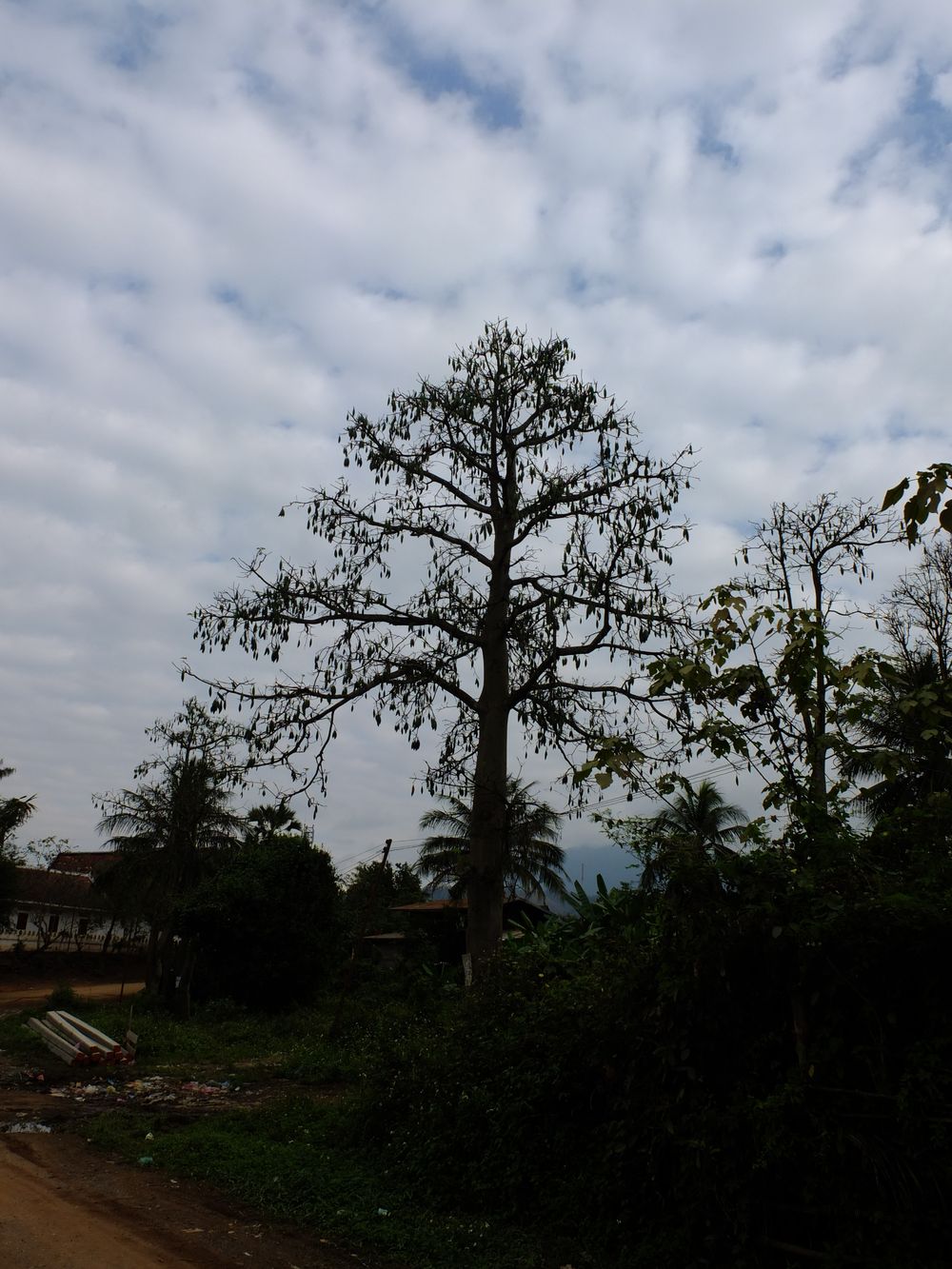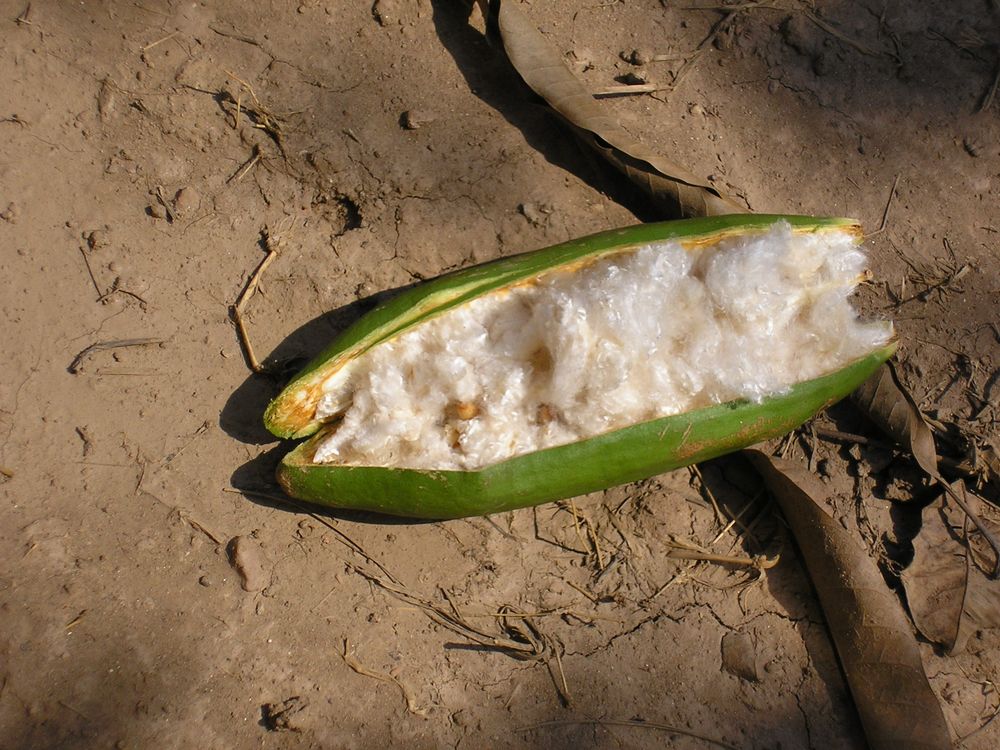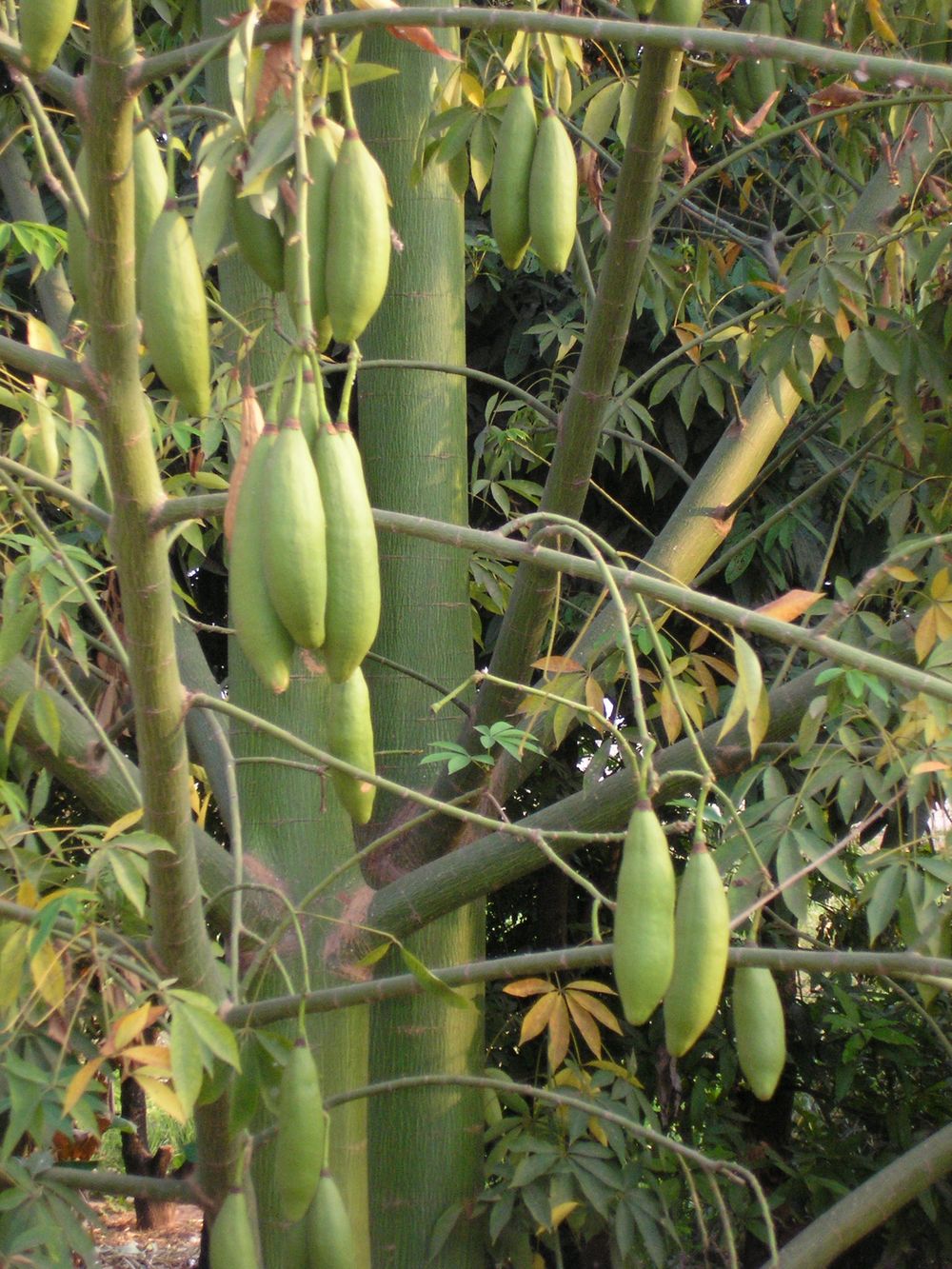Throughout the world, there are a dozen species which the French call ‘kapokier’, and four or five of them are in Laos. Simplified, one can speak of an Asian Silk-Cotton Tree which produces an inferior quality of kapok, and an American or African silk-cotton tree which produces a better quality of kapok, which was much used in the past. The American and Asian species have much the same usages, more for the fibres than for the wood itself.
The great height of this handsome tree, reaching 60 metres in Amazonie, and its graceful appearance, incite numerous societies to consider it a sacred tree. The Mayans believe it connects man to the supernatural world; for West Indians, Surinamese and several cultures, it is the seat of numerous spirits.
The wood of the “ceiba” is light, water-resistant, and in bygone times was used by the Taínos (American Indians who populated the Antilles and gave it the name “ceiba”) to make their long canoes.
The leaves fall during the dry season, the fruit bursts, and the kapok is freed as the seeds are carried by the wind. The kapok fibres are between 1.5-3 cm. and are coated with a wax which renders them water-proof, hence their being used to manufacture life-jackets prior to the advent of synthetic fibres.
In Laos, Silk-Cotton Trees are often planted along the length of village streets, or at the sides of waterways, such as in Vientiane, where some beautiful specimens can be seen along the banks of the Mekong. Traditionally, the kapok is used to fill pillows and mattresses. The oil extracted from the seeds was, at one time, used to provide light. The shoots of the young silk-cotton trees are sometimes harvested to feed animals. The light wood is also used to make toothpicks and matches.
Several parts of the Silk-Cotton Tree are considered to be good medications, essentially tonics. The resin from the trunk, called “Malabar Gum”, is used to treat certain venereal diseases. The bark might strengthen and be good for the blood, and thus help menstrual problems. The flowers might lower fever and “calm the spirit” in connection with the four elements (in the Buddhist faith: earth, water, air, space); always according to Laotian medicinal traditions, the flavour indicates the therapeutic use, this floral astringent from the Silk-Cotton Tree flower might be the sign of a curative activity for stomach ache.
Finally, we note that when the Silk-Cotton Tree is very old, its trunk becomes cottony and becomes home to large worms, which are delicious to eat!
Il existe une dizaine d’espèces de ce que le français nomme kapokier, dans le monde, et 4 ou 5 au Laos; en simplifiant on peut parler d’un kapokier asiatique qui fournit un kapok de qualité inférieure, et un kapokier américain et africain qui donne un kapok de meilleure qualité, très utilisé autrefois. Les espèces américaines et asiatiques ont à peu près les mêmes usages tant pour les fibres que le bois.
La très grande taille de ce bel arbre, jusqu’à 60 mètres en Amazonie, et son port élégant ont incité de nombreuses sociétés à le considérer comme un arbre sacré; chez les Mayas il relie l’homme au monde surnaturel, pour les Antillais, les Surinamiens et plusieurs cultures africaines il est le siège de nombreux esprits.
Le bois du ceiba est léger, résistant à l’eau, et était utilisé autrefois par les Taínos (Indiens d’Amérique qui ont peuplé les Antilles et donné le nom « ceiba ») pour fabriquer leurs longues pirogues.
Les feuilles tombent en saison sèche, le fruit éclate et le kapok est libéré ainsi que les graines emportées par le vent. Les fibres du kapok ont entre 1.5 et 3 cm et sont enduites d’une cire qui les rend imperméables à l’eau, d’où leur utilisation pour faire des gilets de sauvetage avant l’apparition des fibres synthétiques.
Au Laos les kapokiers sont souvent plantés le long des rues de village ou au bord des cours d’eau comme à Vientiane où on trouve encore quelques beaux spécimens le long du Mékong.
Le kapok est utilisé de façon artisanale pour bourrer des oreillers et des matelas.
L’huile extraite des graines était autrefois utilisée pour s’éclairer.
Les pousses des jeunes kapokiers sont parfois récoltées pour nourrir les animaux.
Avec le bois léger on fait des cure-dents et des allumettes
Plusieurs parties du kapokier sont considérées comme de bons médicaments, essentiellement des toniques. La résine du tronc appelée « gomme de malabar » est utilisée pour soigner certaines maladies vénériennes. L’écorce serait fortifiante et bonne pour le sang et donc pour les troubles menstruels. Les fleurs feraient baisser la fièvre et « calmeraient l’esprit » en relation avec les 4 éléments (dans la tradition bouddhique: terre, eau, air, vide); toujours selon la tradition médicale laotienne, la saveur indiquant l’utilisation thérapeutique, celle astringente des fleurs serait l’indice d’une activité curative sur les maux de ventre.
Notons enfin que, lorsque le kapokier est très vieux son tronc devient cotonneux et sert d’habitacle à de gros vers délicieux à manger.




Throughout the world, there are a dozen species which the French call ‘kapokier’, and four or five of them are in Laos. Simplified, one can speak of an Asian Silk-Cotton Tree which produces an inferior quality of kapok, and an American or African silk-cotton tree which produces a better quality of kapok, which was much used in the past. The American and Asian species have much the same usages, more for the fibres than for the wood itself.
The great height of this handsome tree, reaching 60 metres in Amazonie, and its graceful appearance, incite numerous societies to consider it a sacred tree. The Mayans believe it connects man to the supernatural world; for West Indians, Surinamese and several cultures, it is the seat of numerous spirits.
The wood of the “ceiba” is light, water-resistant, and in bygone times was used by the Taínos (American Indians who populated the Antilles and gave it the name “ceiba”) to make their long canoes.
The leaves fall during the dry season, the fruit bursts, and the kapok is freed as the seeds are carried by the wind. The kapok fibres are between 1.5-3 cm. and are coated with a wax which renders them water-proof, hence their being used to manufacture life-jackets prior to the advent of synthetic fibres.
In Laos, Silk-Cotton Trees are often planted along the length of village streets, or at the sides of waterways, such as in Vientiane, where some beautiful specimens can be seen along the banks of the Mekong. Traditionally, the kapok is used to fill pillows and mattresses. The oil extracted from the seeds was, at one time, used to provide light. The shoots of the young silk-cotton trees are sometimes harvested to feed animals. The light wood is also used to make toothpicks and matches.
Several parts of the Silk-Cotton Tree are considered to be good medications, essentially tonics. The resin from the trunk, called “Malabar Gum”, is used to treat certain venereal diseases. The bark might strengthen and be good for the blood, and thus help menstrual problems. The flowers might lower fever and “calm the spirit” in connection with the four elements (in the Buddhist faith: earth, water, air, space); always according to Laotian medicinal traditions, the flavour indicates the therapeutic use, this floral astringent from the Silk-Cotton Tree flower might be the sign of a curative activity for stomach ache.
Finally, we note that when the Silk-Cotton Tree is very old, its trunk becomes cottony and becomes home to large worms, which are delicious to eat!
Il existe une dizaine d’espèces de ce que le français nomme kapokier, dans le monde, et 4 ou 5 au Laos; en simplifiant on peut parler d’un kapokier asiatique qui fournit un kapok de qualité inférieure, et un kapokier américain et africain qui donne un kapok de meilleure qualité, très utilisé autrefois. Les espèces américaines et asiatiques ont à peu près les mêmes usages tant pour les fibres que le bois.
La très grande taille de ce bel arbre, jusqu’à 60 mètres en Amazonie, et son port élégant ont incité de nombreuses sociétés à le considérer comme un arbre sacré; chez les Mayas il relie l’homme au monde surnaturel, pour les Antillais, les Surinamiens et plusieurs cultures africaines il est le siège de nombreux esprits.
Le bois du ceiba est léger, résistant à l’eau, et était utilisé autrefois par les Taínos (Indiens d’Amérique qui ont peuplé les Antilles et donné le nom « ceiba ») pour fabriquer leurs longues pirogues.
Les feuilles tombent en saison sèche, le fruit éclate et le kapok est libéré ainsi que les graines emportées par le vent. Les fibres du kapok ont entre 1.5 et 3 cm et sont enduites d’une cire qui les rend imperméables à l’eau, d’où leur utilisation pour faire des gilets de sauvetage avant l’apparition des fibres synthétiques.
Au Laos les kapokiers sont souvent plantés le long des rues de village ou au bord des cours d’eau comme à Vientiane où on trouve encore quelques beaux spécimens le long du Mékong.
Le kapok est utilisé de façon artisanale pour bourrer des oreillers et des matelas.
L’huile extraite des graines était autrefois utilisée pour s’éclairer.
Les pousses des jeunes kapokiers sont parfois récoltées pour nourrir les animaux.
Avec le bois léger on fait des cure-dents et des allumettes
Plusieurs parties du kapokier sont considérées comme de bons médicaments, essentiellement des toniques. La résine du tronc appelée « gomme de malabar » est utilisée pour soigner certaines maladies vénériennes. L’écorce serait fortifiante et bonne pour le sang et donc pour les troubles menstruels. Les fleurs feraient baisser la fièvre et « calmeraient l’esprit » en relation avec les 4 éléments (dans la tradition bouddhique: terre, eau, air, vide); toujours selon la tradition médicale laotienne, la saveur indiquant l’utilisation thérapeutique, celle astringente des fleurs serait l’indice d’une activité curative sur les maux de ventre.
Notons enfin que, lorsque le kapokier est très vieux son tronc devient cotonneux et sert d’habitacle à de gros vers délicieux à manger.








Throughout the world, there are a dozen species which the French call ‘kapokier’, and four or five of them are in Laos. Simplified, one can speak of an Asian Silk-Cotton Tree which produces an inferior quality of kapok, and an American or African silk-cotton tree which produces a better quality of kapok, which was much used in the past. The American and Asian species have much the same usages, more for the fibres than for the wood itself.
The great height of this handsome tree, reaching 60 metres in Amazonie, and its graceful appearance, incite numerous societies to consider it a sacred tree. The Mayans believe it connects man to the supernatural world; for West Indians, Surinamese and several cultures, it is the seat of numerous spirits.
The wood of the “ceiba” is light, water-resistant, and in bygone times was used by the Taínos (American Indians who populated the Antilles and gave it the name “ceiba”) to make their long canoes.
The leaves fall during the dry season, the fruit bursts, and the kapok is freed as the seeds are carried by the wind. The kapok fibres are between 1.5-3 cm. and are coated with a wax which renders them water-proof, hence their being used to manufacture life-jackets prior to the advent of synthetic fibres.
In Laos, Silk-Cotton Trees are often planted along the length of village streets, or at the sides of waterways, such as in Vientiane, where some beautiful specimens can be seen along the banks of the Mekong. Traditionally, the kapok is used to fill pillows and mattresses. The oil extracted from the seeds was, at one time, used to provide light. The shoots of the young silk-cotton trees are sometimes harvested to feed animals. The light wood is also used to make toothpicks and matches.
Several parts of the Silk-Cotton Tree are considered to be good medications, essentially tonics. The resin from the trunk, called “Malabar Gum”, is used to treat certain venereal diseases. The bark might strengthen and be good for the blood, and thus help menstrual problems. The flowers might lower fever and “calm the spirit” in connection with the four elements (in the Buddhist faith: earth, water, air, space); always according to Laotian medicinal traditions, the flavour indicates the therapeutic use, this floral astringent from the Silk-Cotton Tree flower might be the sign of a curative activity for stomach ache.
Finally, we note that when the Silk-Cotton Tree is very old, its trunk becomes cottony and becomes home to large worms, which are delicious to eat!
Il existe une dizaine d’espèces de ce que le français nomme kapokier, dans le monde, et 4 ou 5 au Laos; en simplifiant on peut parler d’un kapokier asiatique qui fournit un kapok de qualité inférieure, et un kapokier américain et africain qui donne un kapok de meilleure qualité, très utilisé autrefois. Les espèces américaines et asiatiques ont à peu près les mêmes usages tant pour les fibres que le bois.
La très grande taille de ce bel arbre, jusqu’à 60 mètres en Amazonie, et son port élégant ont incité de nombreuses sociétés à le considérer comme un arbre sacré; chez les Mayas il relie l’homme au monde surnaturel, pour les Antillais, les Surinamiens et plusieurs cultures africaines il est le siège de nombreux esprits.
Le bois du ceiba est léger, résistant à l’eau, et était utilisé autrefois par les Taínos (Indiens d’Amérique qui ont peuplé les Antilles et donné le nom « ceiba ») pour fabriquer leurs longues pirogues.
Les feuilles tombent en saison sèche, le fruit éclate et le kapok est libéré ainsi que les graines emportées par le vent. Les fibres du kapok ont entre 1.5 et 3 cm et sont enduites d’une cire qui les rend imperméables à l’eau, d’où leur utilisation pour faire des gilets de sauvetage avant l’apparition des fibres synthétiques.
Au Laos les kapokiers sont souvent plantés le long des rues de village ou au bord des cours d’eau comme à Vientiane où on trouve encore quelques beaux spécimens le long du Mékong.
Le kapok est utilisé de façon artisanale pour bourrer des oreillers et des matelas.
L’huile extraite des graines était autrefois utilisée pour s’éclairer.
Les pousses des jeunes kapokiers sont parfois récoltées pour nourrir les animaux.
Avec le bois léger on fait des cure-dents et des allumettes
Plusieurs parties du kapokier sont considérées comme de bons médicaments, essentiellement des toniques. La résine du tronc appelée « gomme de malabar » est utilisée pour soigner certaines maladies vénériennes. L’écorce serait fortifiante et bonne pour le sang et donc pour les troubles menstruels. Les fleurs feraient baisser la fièvre et « calmeraient l’esprit » en relation avec les 4 éléments (dans la tradition bouddhique: terre, eau, air, vide); toujours selon la tradition médicale laotienne, la saveur indiquant l’utilisation thérapeutique, celle astringente des fleurs serait l’indice d’une activité curative sur les maux de ventre.
Notons enfin que, lorsque le kapokier est très vieux son tronc devient cotonneux et sert d’habitacle à de gros vers délicieux à manger.


